《中国文化要览与翻译》课程思政优秀案例设计书
外语学院
吴彩霞(负责人)
一、课程概括
《中国文化要览与翻译》是针对非英语专业学生开设的一门选修课,旨在帮助学生更好地了解中国文化,学习常用的英语表达,并利用相应的翻译技巧对中国文化中代表性的历史、哲学、文学、艺术、习俗等各方面的内容,如饮食、节日习俗、习语典故等进行比较地道的翻译,让学生掌握基本的翻译技巧,熟悉中西方文化的差异并培养其跨文化交际能力。同时,大学英语四六级改革加入的段落翻译主要也是关于中国文化特色的,本课程也能帮助学生更好地应对考试。
二、课程目标
(一)知识目标
引导学生全面、系统地了解中国文化的核心内容和主要特征,包括历史、哲学、文学、艺术、宗教、习俗等多个方面。
帮助学生理解翻译在文化交流中的重要性,掌握翻译的基本理论,并能在实践中灵活应用。
学习与中国文化相关的英语词汇和表达方式,如传统节日、历史名人、文化符号等,掌握特有的成语、谚语、俗语等,并能在翻译和写作中准确应用。
(二)能力目标
提高学生的英语语言能力,特别是翻译能力,使他们能够读懂并准确翻译与中国文化相关的文本,确保信息的准确性和完整性。
培养学生跨文化意识和文化交际能力,使他们能够用流利的英语向外国友人介绍中国文化,促进中外文化交流。
激发学生对中国文化研究的兴趣,培养他们的学术素养和探究精神。
价值目标
通过对中国文化的全面介绍和深入学习,使学生深入理解和认同中华文化的博大精深和独特魅力,从而增强民族自豪感和文化自信。
增强学生的跨文化意识,使他们能够理解并尊重不同文化之间的差异,避免在跨文化交流中出现误解和冲突。
培养学生的社会责任感,使他们意识到自己在传承和弘扬中国文化中的重要作用,积极为推广中国文化作出贡献。
思政元素
教学内容 | 思政元素 |
翻译的基本原则与方法 | 平等与尊重、诚信与责任 |
中国文化之节日习俗 | 尊重文化多样性、注重亲情、尊老爱幼、感恩先人、爱国主义 |
哲学与宗教 | 尊重与理解、传承与弘扬哲学思想、正确的信仰观念 |
中国文化之饮食翻译 | 健康饮食、文化自信、珍惜食物 |
中国文化之色彩翻译 | 尊重文化多样性、培养审美观念、传播色彩文化 |
中国文化之动植物翻译 | 生命平等、生态平衡、传播科普知识 |
中国文化之民间工艺翻译 | 文化传承、文化自信、培养民族精神 |
中国文化之传统建筑翻译 | 民族自豪感、文化自信、保护文化遗产 |
中国文化之习语典故翻译 | 文化传承与弘扬、促进文化交流 |
设计思路
由于中国文化内容丰富,二课程时间有限,本课程选取了中国文化中有代表性的教学内容根据话题进行分类学习。
1. 课前,把有些背景词汇或内容做成相应的PPT或微视频,提前一周上传到雨课堂,并设置讨论任务,供学生自学讨论,课堂主要是实践应用。
2. 课堂上采用多种教学模式,主要是教师讲授部分重难点内容,其他内容分配给学生以小组为单位进行PPT制作并展示,或者是段落翻译实践练习,让学生学以致用,敢于把所学知识表达出来。
3. 课后任务巩固:每个类别学完后,要求学生以词汇表达听写、段落翻译、延伸阅读或英语微视频等方式巩固本类别相关内容,加深理解和掌握。
4. 拓展延伸:每个类别收集相关的文献、视频等课外材料,并推荐给学生阅读观看,以讨论任务或写读后感的方式检查督促。
五、实施案例
案例1:中国文化之节日习俗
一、教学目标:
1)知识目标:了解各种中国节日,掌握与中国节日相关的翻译表达。
2)能力目标:通过练习,提高翻译能力;对比了解中西方节日,增强跨文化交际能力。
3)思政目标:通过了解学习中国节日的来源、发展历史、习俗等,增强文化自信,培养亲情意识、感恩精神以及爱国主义精神;学习掌握和中国节日有关的英文表达,把中国的节日文化传播出去。
二、教学重点:掌握常见节日相关的英文表达;对比了解中西方节日文化
三、教学难点:用英文介绍中国节日
四、教学过程:
4.1 导入---恰逢国庆节,提问
1)国庆节用英语怎么表达?
2)国庆节通常有些什么活动?
3)如何翻译这段文字?有什么困难?
10月1日上午,为庆祝中华人民共和国成立70周年,在北京天安门广场举行了盛大的阅兵仪式和精彩纷呈的群众**(mass pageantry)。晚上,数万群众参加了盛大的联欢活动。烟花点亮北京的夜空。
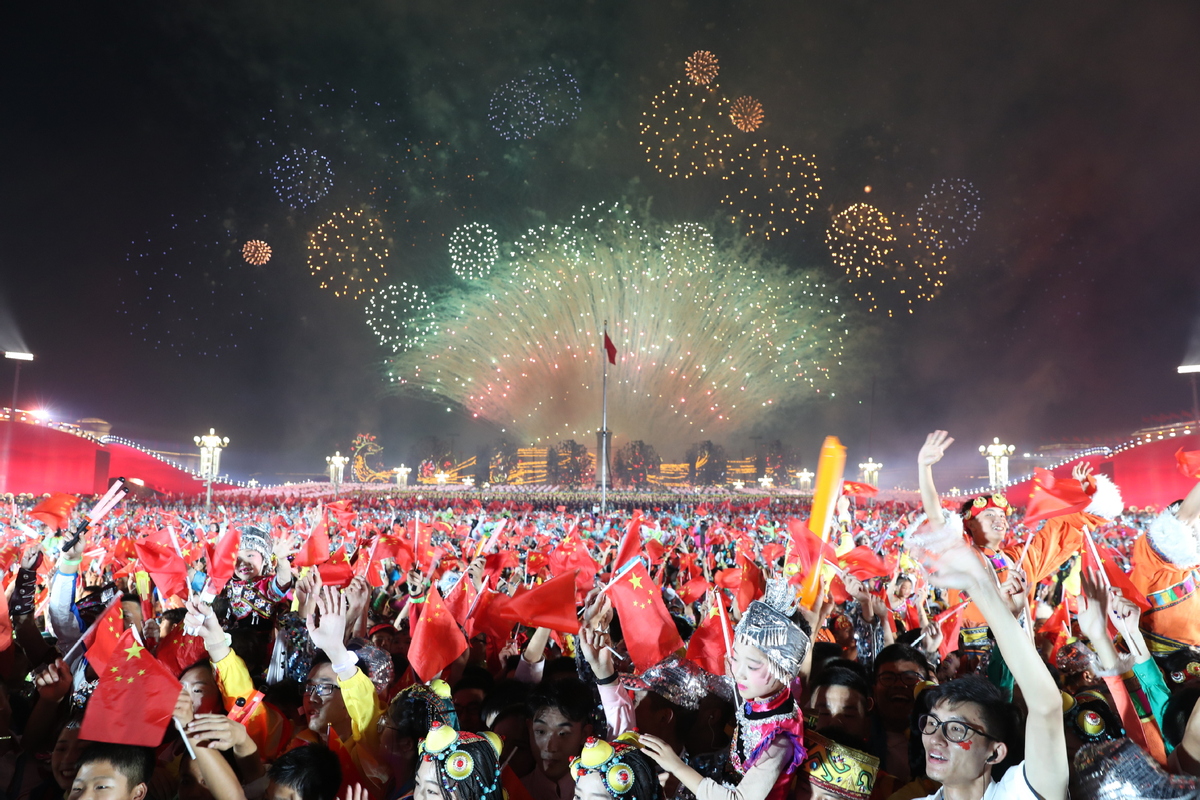
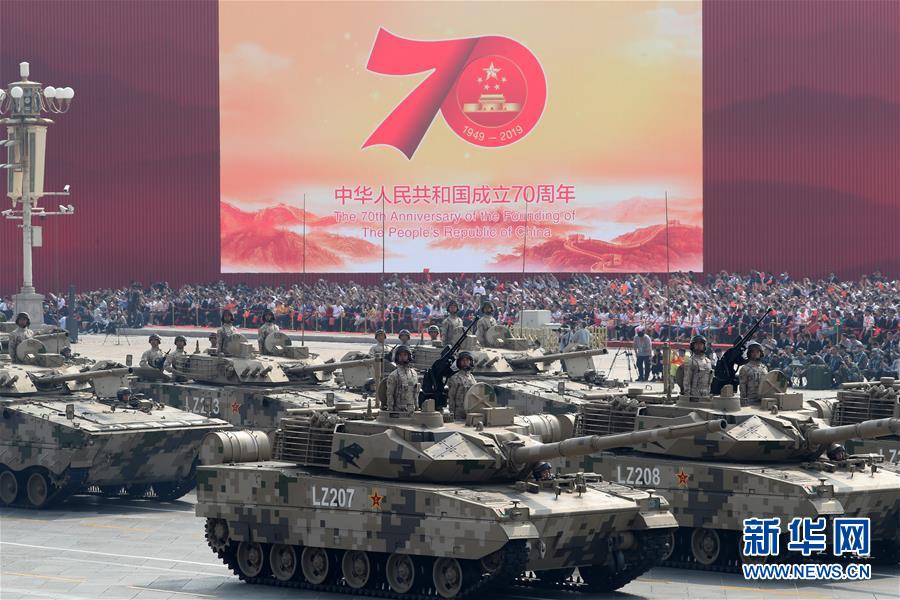
阅兵military parade
中华人民共和国成立70周年
celebrate the 70th anniversary of the People's Republic of China's founding
群众**mass pageantry
联欢活动evening gala
4)还知道哪些节日?
4.2 教师讲解
4.2.1 Origin of Chinese Festival
The formation of traditional festivals is a long process of historical and cultural accumulation in a nation or a state.
日历 connected with ancient astronomy, calendars and mathematics
精神需求 primitive sacrifice, superstitious taboo and earthly life, people's spirit and religious influence
历史人物 historical figures, showing people's commemoration
4.2.2 Chinese calendars
Lunar calendar阴历/农历
Solar calendar阳历
二十四节气Jieqi, or the 24 seasonal division points, is a key factor in forming traditional festivals. According to the traditional Chinese calendar, a year is divided into 24 points, which can accurately show seasonal changes and acts as a basic guidance system for agricultural production. The 24 seasonal division points came into being in the Warring States Period (475 BC-221 BC).
腊八节Laba Festival
冬至Winter Solstice
4.2.3 中国传统节日
春节(农历正月初一)
the Spring Festival (the 1st Day of the Chinese lunar calenda
元宵节 (灯节) (农历正月十五)
the Lantern Festival /the 15th day of the first lunar month
清明节(四月五日前后)
the Qingming Festival/Tomb-sweeping Festival
端午节(农历五月初五)
the Dragon-Boat Festival/Duanwu Festival
情人节(农历七月初七)
the Double-Seventh Day/the Chinese Valentine’s Day
中秋节(农历八月十五)
the Mid-Autumn Festival (the Moon Festival)
重阳节(农历九月初九)
the Double-Ninth Festival/Chong Yang Festival
4.2.4 其他节日
妇女节(3.8)Women’s Day
劳动节(5.1)Labor Day/May Day
儿童节(6.1)Children’s Day
国庆节(10.1)the National Day
4.3 翻译篇章练习
在中国的传统节日中,春节是一个最重要、最热闹的节日。中国人过春节有很多传统习俗。比如除夕之夜,是家人团聚的时候,一家人围坐在一起,吃一顿丰盛的年夜饭 (New Year’s Eve dinner),说说笑笑,直到凌晨,这叫守岁(staying up to see the year out)。拜年也是春节的重要习俗,从正月初一开始,人们要走亲访友,互相拜年(greet each other)。 放爆竹(set off firecrackers)是春节期间孩子们最喜欢的活动。传说燃放爆竹可以驱妖除魔(drive off evil spirits)。
4.3.1 课前导入:PPT展示问题
你知道哪些关于春节的习俗?
如何用英语表达下面这些说法?
春节,除夕,年夜饭,农历正月初一,守岁,拜年,贴春联,放爆竹,压岁钱
春节的起源
The Spring festival is also known as the Chinese New Year, which is the most important traditional festival in China. It falls on the first day of the first Chinese lunar month. In ancient time, a demon(怪物) called “Nian” that lived under the sea would hurt people once a year on the new year eve. It jumped out from the sea, attacked villages, devoured(吞食) people and animals. Some villagers suggested that the demon was afraid of loud noises, red color and flames. So they lighted firecrackers, put on red couplets (对联)on their gates, beat gongs (锣)and drums to drive “Nian” away. Since then, the custom and tradition of celebrating the Spring Festival were born.
4.3.2 分析翻译篇章:PPT展示
分析原文
1) 看懂原文大意。
2) 逐句分析,看看哪些句子可以直接顺着翻译,哪些需要调整结构,使用从句。
3) 找出较难的词汇表达。
找出重难点词汇:
农历in Chinese lunar calendar
传统习俗 traditional customs
除夕New Year’s Eve
团聚reunion
传说according to legend
处理难句
断句
找主干(主谓宾)
处理其他部分
1) 比如除夕之夜,是家人团聚的时候,一家人围坐在一起,吃一顿丰盛的年夜饭 (New Year’s Eve dinner),说说笑笑,直到凌晨,这叫守岁(staying up to see the year out)。
断句
注意多个动词的处理:找好谓语动词,其他的动词转换成非谓语动词。
尝试把分句组合:which 指代前面整体
For example, New Year’s Eve is the time for a happy reunion of all the family members, when they sit around the table to have a bumper New Year’s Eve dinner, talking and laughing, until daybreak, which is called “staying up to see the year out”.
2)拜年也是春节的重要习俗,从正月初一开始,人们要走亲访友,互相拜年(greet each other)。
断句
Greeting is an important custom for the Spring Festival. From the first day of the lunar year, people visit relatives and friends, to greet each other.
From the first day of the lunar year, people visit relatives and friends, to greet each other, which is an important custom for the Spring Festival.
全文翻译参考
Among the traditional Chinese festivals, this is the most important and the most bustling festival. Chinese have many traditional customs relating to the Spring Festival. For example,New Year’s Eve is the time for a happy reunion of all the family members, when they sit around the table to have a bumper New Year’s Eve dinner, talking and laughing, until daybreak, which is called “staying up to see the year out”. From the first day of the lunar year, people visit relatives and friends, to greet each other, which is an important custom for the Spring Festival. Setting off firecrackers is the favorite activity of children in the Spring Festival, which could drive off evil spirits according to legend.
扩展补充
春节相关表达
4.4 西方节日
4.4.1 有哪些西方节日?

4.4.2 讨论
如何看待年轻人更倾向于过洋节?
你觉得怎样才能更好地传播中国节日文化?
视频赏析:如何向外国人介绍中国节日
4.5 小组任务
制作关于中西方节日对比PPT,要求中英对照,可配图片、短视频,下周小组派一人讲解介绍,可提问讨论。具体内容:
分别介绍中国节日和西方节日,要求包含历史起源、习俗活动、影响等
比较中西方节日异同
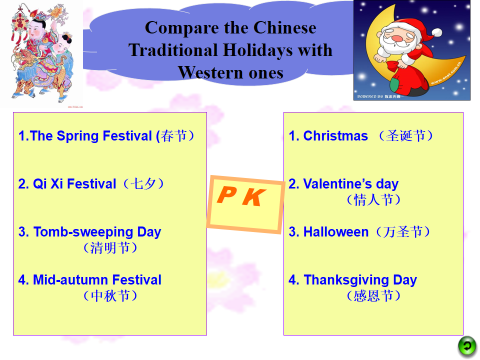
4.6 小组展示
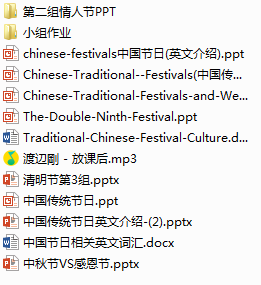
案例2:中国文化之饮食翻译
一、教学目标:
1)知识目标:了解日常生活中食物相关的英文表达;学会如何翻译介绍中国菜式;了解饮食在中国文化中的重要性和意义。
2)能力目标:通过学习饮食表达和翻译技巧提高翻译能力;对比了解中西方饮食文化的历史和发展,增强跨文化交际能力。
3)思政目标:感受中国饮食文化底蕴,增强文化自信;能意识到健康饮食的重要性;积极传播中国饮食文化。
二、教学重点:了解常见食物及其英文表达;翻译不同菜式
三、教学难点:翻译不同菜式
四、教学过程:
4.1 课前雨课堂资源学习
各种食物英文翻译,包括食材、调味料
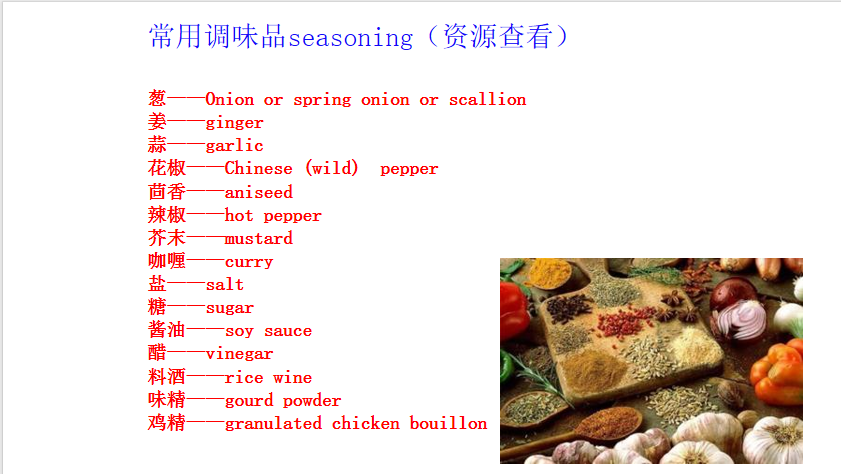
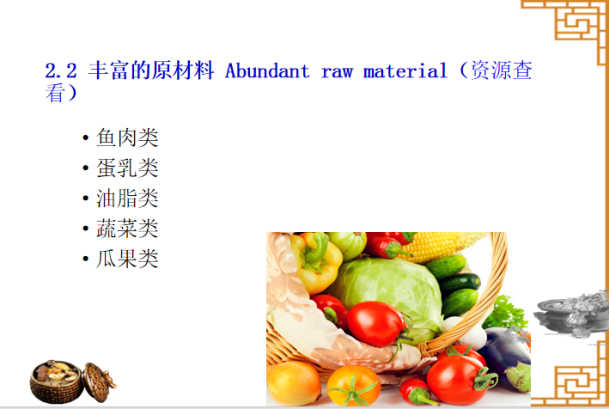
烹饪方法介绍


4.2 背景介绍
4.2.1 Importance of Diet in Chinese culture
Diet penetrates into every corner of our life.
In greeting ------你吃了吗?
In welcoming guests-----a table of luxurious meal
In building up relationship ------酒杯一端,政策放宽;筷子一提,可以可以
In mourning for the dead or sacrifice for gods
民以食为天。 ---Food is the first necessity of the people.
食色,性也。---Desire for food and sex are basic human instincts.
繁体字“國”----- 抄起武器“戈”以保护“口”。
4.2.2 Features of Chinese diet
味道Taste is the core in Chinese cuisine.
Three essential factors in Chinese cooking:
色:color
香:aroma
味:taste
民以食为天,食以味为先。
五味调和,味道为王 。
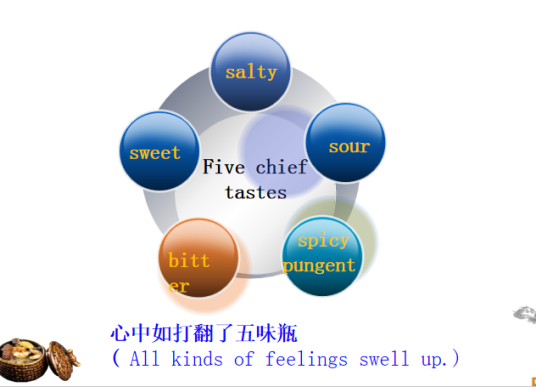
The aim of flavoring in Chinese cuisine is to rid any unpleasant taste and **ell, to highlight the source taste, to improve and enrich its taste. All these can be achieved only when you put proper amount, at proper time and with proper heat.
五味调和是中国烹饪艺术所追求的最高境界。根据伊尹(夏末商初的厨师,被誉为‘厨神’),调和在于三样东西:水,火和味(五味)。
原料Abundant raw materials
加工Elaborate processing of materials
营养Nutrition of Chinese diet
Nutrition of Chinese diet
神农氏
扁鹊------安身之本,必资于食。救疾之速,必凭于药。
Food is the essential supply for one’s health while medicine serves as a rapid solution to one’s sickness.
五谷为养,五果为助,五畜为益,五菜为充。
Cereals supply men with necessary nutrition, fruit is a subsidiary, meat is an added benefit and vegetables are nutritional enrichment. A diversified diet helps maintain the function of the organs.
-------《黄帝内经》(the Yellow Emperor’s Classics of Internal Medicine)
食医---food therapy
Nutrition supply from food aims at achieving balance in one’s body while taking medicine aims at solving problems.
四季养生
咸多伤心;苦多伤肺;辛多伤肝;酸多伤脾;甘多伤肾。
清淡:小米; 菊花; 腊八粥;
Philosophy of yin and yang
People believe that each food has its own characteristics of yin and yang.
Yin foods are thin, cool and low in calories. Yang foods are rich, spicy and high in calories.
For human body, only when yin and yang are in balance can we be healthy.
4.3 Translation of Chinese menu
When you eat Chinese dishes with foreigners,how will introduce the cuisines to them?
童子鸡
东坡肉
龙凤斗
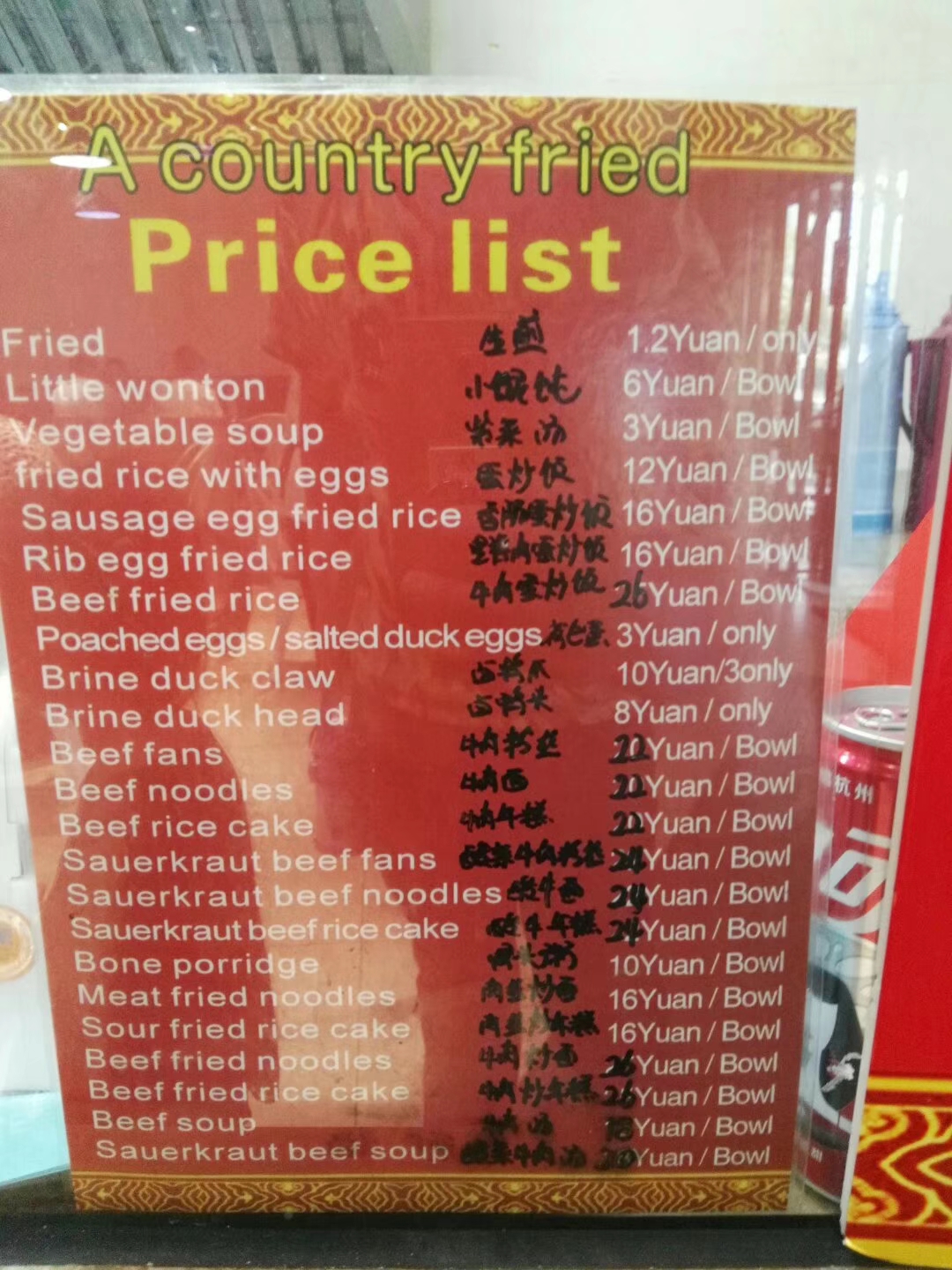
For menu translation, the expected communicative function among the target readers must be achieved. The target readers must know what the dish is about; if possible, to appreciate the delicate naming.
4.3.1翻译方法:
“写实”型菜肴——直译
This is the simplest situation for translation: translate literally the materials, ingredients, cooking methods, cutting methods, flavors etc;
1、烹调法+主料名
炖牛肉 stewed beef
煎鸡蛋 fried eggs
炸春卷deep-fried egg rolls
叉烧肉barbecued pork
2、烹调法+主料名+with/in+配料
油焖笋 stewed bamboo shoot with soy sauce
咸水鸭 boiled shrimps with salt
香菇蒸鸡 steamed chicken with mushrooms
红烧猪肉 braised pork with sauce
荷叶粉蒸鸡 steamed chicken in lotus leaf packets
3、烹调法+加工法+主料名+ with/in+配料
肉片烧豆腐 stewed sliced pork with beancurd
红烧狮子头 stewed minced pork balls with brown sauce
洋葱牛肉丝 fried shredded beef with onion
青椒肉片 fried sliced pork with green chilli
“写意型”菜肴名——意译
Translate figuratively --- if allows, brief the figurative naming; otherwise, introduce the materials, ingredients, cutting methods, cooking methods or flavors
龙凤会 Stewed snake and chicken
翡翠羹 Vegetable Soup
狮子头 Braised Meat Balls in Brown Sauce
*** Stewed Snake and Wild Cat
鸳鸯火锅 Hotpot with one half Hot and another Light
芙蓉鸡片 Fried Chicken Slices with Egg-white
羊蝎子 Lamp Spine Hotpot
(三)典故型——直译/意译+解释
1、以人名/地名命名的,人名/地名用音译,菜名用直译的方法
东坡肉 Dongpo braised pork
叫花鸡 beggar’s chicken
北京烤鸭 Beijing roast duck
2、有些菜名是以传说、典故命名的。按写实型的译法,然后用括号加上菜名的直译和解释。
佛跳墙 assorted meat and vegetables cooked in embers (fotiaoqiang——lured by its **ell, even the Buddha jumped the wall)
3、药膳型——药名“简议+注释”
天麻炖山鸡 stewed pheasant with herbs ( with the function of preventing dizziness and curing headache)
(四)体现中国餐饮文化,使用汉语拼音命名或音译
1、具有中国特色且被外国人接受的传统食品,本着推广汉语及中国餐饮文化的原则,使用汉语拼音。
如:饺子 Jiaozi 包子 Baozi
馒头 Mantou 花卷 Huajuan
烧麦 Shaomai
2、 具有中国特色且被外国人接受的,使用地方语言拼写或音译拼写的菜名,仍保留其拼写方式。
如:豆腐 Tofu 宫保鸡丁 Kung Pao Chicken
杂碎 Chop Suey 馄饨 Wonton
3、中文菜肴名称无法体现其做法及主配料的,使用汉语拼音,并在后标注英文注释。如:
佛跳墙 Fotiaoqiang--Steamed Abalone with Shark’s Fin and Fish Maw in Broth
锅贴 Guotie (Pan-Fried Dumplings)
窝头 Wotou (Steamed Corn Bun)
蒸饺 Steamed Jiaozi (Steamed Dumplings)
油条 Youtiao (Deep-Fried Dough Sticks)
汤圆 Tangyuan (Glutinous Rice Balls)
咕噜肉 Gulaorou (Sweet and Sour Pork)
粽子 Zongzi (Glutinous Rice Wrapped in Bamboo Leaves)
元宵 Yuanxiao(Glutinous Rice Balls for Lantern Festival)
驴打滚儿 Lǘdagunr-- Glutinous Rice Rolls Stuffed with Red Bean Paste
艾窝窝 Aiwowo (Steamed Rice Cakes with Sweet Stuffing)
豆汁儿 Douzhir (Fermented Bean Drink)
4.3.2 Major Styles of Chinese Diet
我国八大菜系:
浙菜——zhejiang Style
鲁菜——Shandong Style
闽菜——Fujian Style
苏菜——Jiangsu Style
徽菜——Anhui Style
湘菜——Hunan Style
川菜——Sichuan Style
粤菜——Cantonese Style
4.4 作业任务
1. 熟练掌握常见食材、烹饪方法、配料的英文表达
2. 翻译自己喜欢吃的菜10道,下周带来和同桌相互修改
3. 小组任务:八个组各负责一种菜系,要求如下:
特色菜图片、中英文翻译
各菜系的特点中英文介绍
做成PPT下周展示讨论
案例3:中国文化之传统建筑翻译
一、教学目标:
1)知识目标:了解中国传统建筑的特点及类型;学习和传统建筑相关的英文表达;了解传统建筑在中国文化中的重要意义。
2)能力目标:通过学习传统建筑相关表达提高翻译能力;增强跨文化交际能力。
3)思政目标:学会欣赏传统建筑的美,增强文化自信;提升保护传统建筑的意识。
二、教学重点:了解常见传统建筑及其英文表达;翻译建筑类段落
三、教学难点:翻译建筑类段落
四、教学过程:
4.1 导入---猜建筑图片名
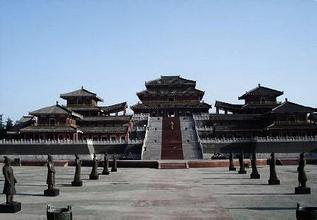

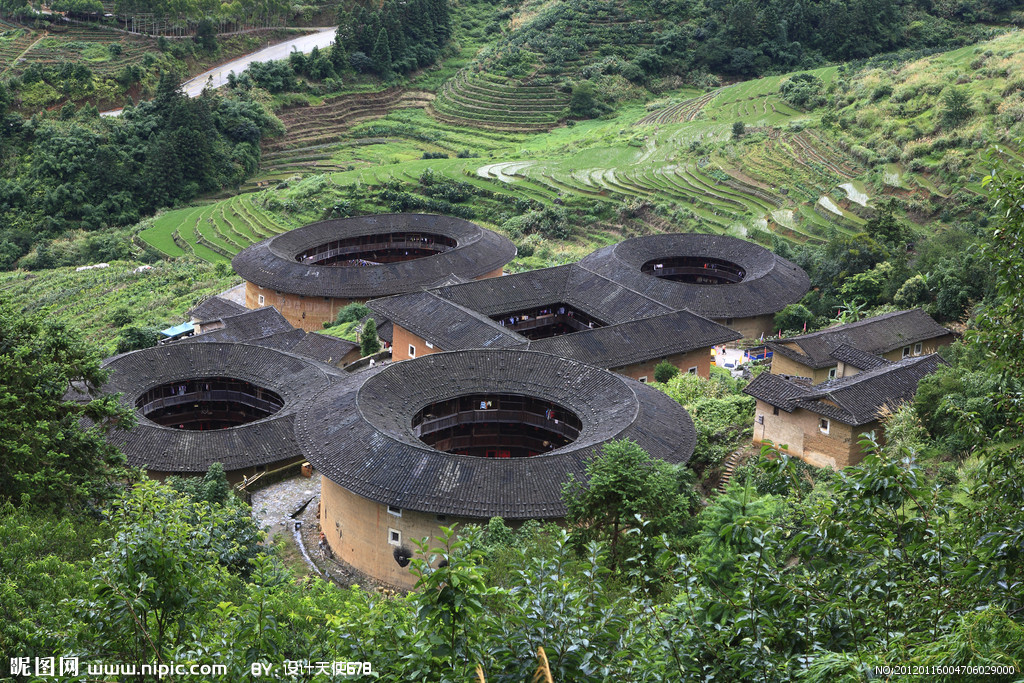
4.2 中国传统建筑介绍
西方建筑、***、中国:世界三大建筑
唯一以木结构为主的建筑体系
the timber skeleton as its main structure
4.2.1 发展历史
*Paleolithic Age 旧石器时代
sheltered in trees and natural caves
* Neolithic Age 新石器时代
simple houses in the caves (地穴式建筑) or half cave-in houses(半地穴式建筑) with wood, mud and grass;
*Qin Dynasty
E Pang Palace
the Emperor Qin Shihuang's Mausoleum
the Great Wall
the Dujiangyan Water-Conservancy Project
*Five-Kingdoms-Song-Liao-Jin Period
stressed constructing palaces,but have been nearly destroyed
many pagodas and stone steles(石碑) were constructed with high standard and fine workmanship
*Yuan,Ming and Qing Dynasties
imperial palaces and the constructions amazed the world
*Nowadays
traditional architectural activities have sloewd down and more western factors have begun to show up
4.2.2 中国传统建筑特点
*Features of Traditional Chinese Architecture
--emphasis on the horizontal水平铺开
--emphasis on symmetry平衡与对称
--making houses face south朝南
----most Chinese buildings are built with either red or gray bricks, but wooden structures, a unique timber framework木质框架walls/ flexibility and adaptability/springy
--a Fengshui风水 practitioner or a diviner, usually applies theories as Yin-Yang(阴阳), Si Xiang(四象),Wu Xing(五行) and Ba Gua(八卦) to select an optimal place for burial or accommodation.
--roof and symboli**
*Deeply rooted in traditional Chinese culture, ancient Chinese architecture boasts the following national cultural connotations:
Readability可读性
Ancient Chinese architecture, like a silent cultural language, bears rich cultural symbols that reveal Chinese beliefs in life and society.
Introversion内在性
Unlike many foreign buildings, which attach much importance to external appearance, some Chinese ancient buildings are simple externally but enjoy internal richness.
Two typical examples are the Chinese Quadrangle (Siheyuan) and Gardens in Suzhou of East China's Jiangsu Province .
Super-Stability超稳定性
Ancient Chinese architecture has remained almost unchanged over thousands of years due to a long history of feudal society in which people embraced similar values and lifestyles.
Interdependence相互依赖
Everything in the world is interdependent and one can never learn anything without placing it into a more general environment; Ancient Chinese architecture is no exception.
4.2.3 建筑分类
*按结构分类
*亭Chinese pavilions
Chinese Pavilions are covered structures without surrounding walls.
Types of Chinese Pavilion:
Round, square, triangular, hexagonal(六角亭), octagonal(八角亭)pavilions, etc.
Functions of Chinese Pavilion:
Practical function:
—used for military and governmental purposes
—as a place for rest
—as a roof to a stone tablet
Aesthetic function:
Pavilions provided a place to sit and enjoy the scenery, and they also became part of the scenery itself, being attractive structures.
*台Terraces
As an ancient architectural structure of Chinese, the tai was a very much elevated terrace with a flat top, generally built of earth and stone and surfaced with brick.
Functions of terraces :
—as an observatory (观象台)
—as beacon towers(烽火台) along the Great Wall
—in honor of the sincere friendship
*楼multi-story buildings
A lou can refer to any building oftwo or more storeys with a horizontal
main ridge.
Functions of multi-story buildings :
—for military use
—as private homes
—as belvederes(望景楼)
—as bell and drum towers
*阁 storyed pavilions (usu. two)
Functions of storyed pavilions :
—used in ancient times for the storage of important articles
and documents
—a place where educated men used to gather to write articles and hold banquets
—used for enjoying the sights
*按功能分类
*Imperial Palaces(宫殿建筑)
Usually built on a grand scale, the imperial palaces are closely related to imperial sovereignty and were also constructed for the entertainment of rulers.
Architectural Features of imperial palaces:
--The ancient palaces were strictly laid out on central axis.
-- Yellow roof tiles were used.
--The wooden columns of the buildings, as well as the surface of the walls, tend to be red in color.
--The Chinese dragon was heavily used on Imperial architecture.
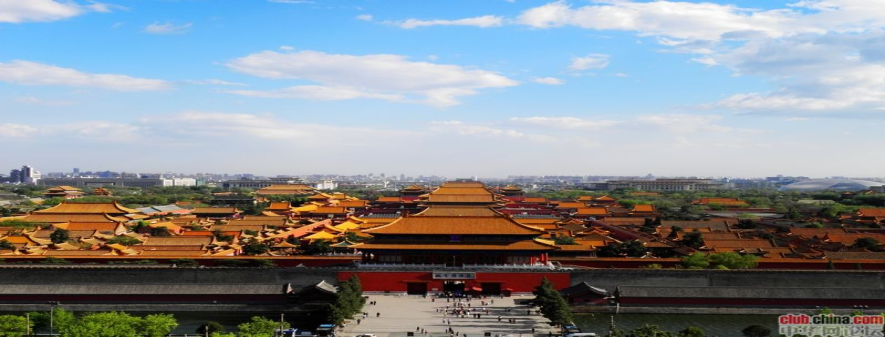
紫禁城 the Forbidden City
*Traditional Chinese Gardens(园林建筑)
The most distinguishing feature of traditional Chinese gardens is their natural mountain-and-water style. Chinese garden architecture includes both grand imperial gardens and delicate private ones.
颐和园 the Summer Palace

*Altars and Temples (坛庙建筑)
Altars and temples built in ancient China were meant for practice of rites.
Three categories:
—imperial temples and altars for worshiping of Heaven, the earth, the sun, the moon and the imperial ancestors
—commemorative temples for dead people of great virtue
—family temples
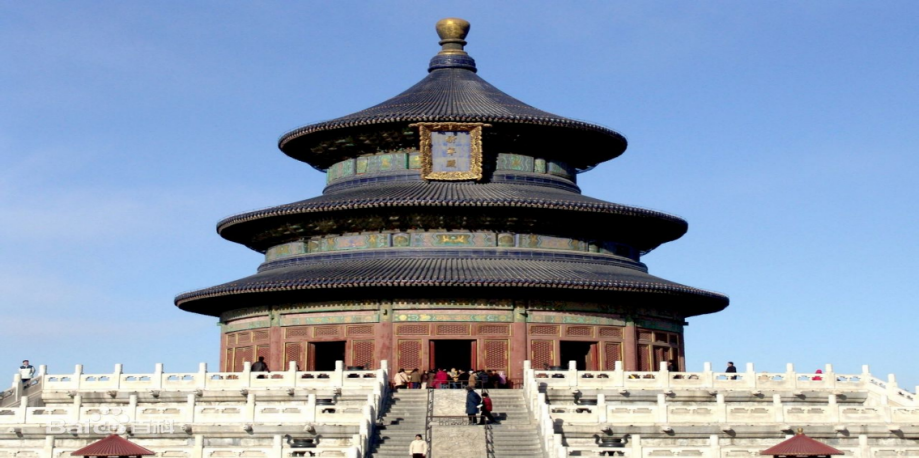
天坛 the Temple of Heaven
*Religious Structures(宗教建筑)
Taoist Temple Constructions
A Chinese Taoist temple, generally called gong(宫) or guan(观) in Chinese, is the holy hall where Taoists perform their religious ceremonies.
青城山The Qingcheng Mountain
*Tombs and Mausoleums(陵墓建筑)
People of all social classes had their tombs carefully built.
Over the centuries, the craft of tomb construction gradually merged with arts like painting, calligraphy and sculpture. It eventually became its own art form.
*Residential Houses(民居建筑)
Residential houses refer to the house of the common people in different parts of China.
Five major styles of residential huoses in China:
--Courtyard House (四合院)
-- Cave Dwelling (窑洞式民居)
--Earthen Building (土楼)
--Stilt House/Pile Dwelling(吊脚楼)
--Yurt (蒙古包)
-- Flat-roof House (碉房)
4.3 作业
1. 小组选取一种类型建筑进行介绍
2.段落翻译练习
中国园林是经过三千多年演变而成的独具一格的园林景观。它既包括为皇室成员享乐而建造的大型花园,也包括学者、商人和卸任的政府官员为摆脱嘈杂的外部世界而建造的私家花园。这些花园构成了一种意在表达人与自然之间应有的和谐关系的微缩景观。典型的中国园林四周有围墙,园内有池塘、假山、树木、花草以及各种各样由蜿蜒的小路和走廊连接的建筑。漫步在花园中,人们可以看到一系列精心设计的景观犹如山水画卷一般展现在面前。
莀参考译文:
羈After 3,000 years of evolvement, Chinese gardens have become a unique landscape. This includes both large gardens built as entertainment venues for royal family, and private gardens built as secluded retreats for scholars, merchants and retired government officials. These gardens have constituted a miniature that is designed in praise of the harmony between man and nature. A typical Chinese garden is surrounded by walls and consists of various buildings linked by winding trails and corridors, with ponds, rockeries, trees, and flowers scattered in it. Wandering in such a well-designed garden, people may feel that they are walking in a landscape painting.
六、特色及创新
(一)突出文化性:本课程以中国文化为核心内容,旨在培养学生的文化自觉和文化自信。
(二)注重实践性:通过翻译实践、案例分析等方式,提高学生的实践能力和跨文化交际能力。
(三)创新教学方法:采用讲授法、讨论法、实践法等多种教学方法相结合,激发学生的学习兴趣和积极性。
(四)在线教学:利用网络平台进行在线教学,为学生提供更多的学习资源和交流机会。
七、教学效果
(一)知识掌握与理解:学生比较系统全面了解了中国文化的精髓和核心要义;掌握了中国文化翻译的基本理论和技巧;学到了中国文化相关的词汇表达,并能较为准确地用外语表达中国文化。
(二)技能提升与实践:学生的翻译技能得到了显著提升,能够独立完成一定难度的中国文化文本翻译任务,并能在翻译实践中灵活运用所学知识解决遇到的问题,提高翻译的准确性。
(三)跨文化交际能力提升:通过本课程的学习,学生能够更好地理解和欣赏不同文化文化背景下的思想和文学艺术作品,能更加自信地介绍中国文化,促进了中外文化的交流和传播。
(四)教学评估与反馈:学生的课程考核成绩平均达到83分,说明学生在知识掌握和技能提升方面得到了提升。此外,通过评教,了解到学生对本课程的满意度较高,普遍认为课程内容丰富、实用,教学方法灵活多样,能够激发学生的学习兴趣和积极性。
